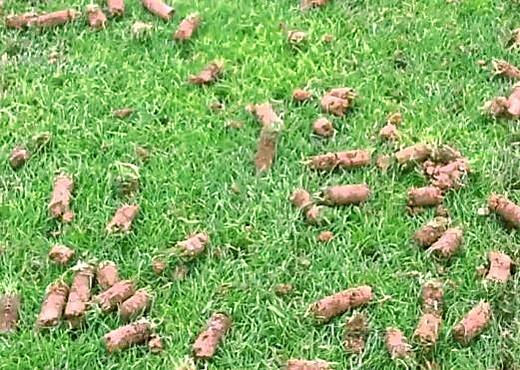Aerating Basics
- Kyle Morehouse

- Aug 12, 2020
- 2 min read
Updated: Aug 12, 2021
It's hard to believe that fall is on its way, but the nights are already getting cooler, and the sun is setting just a little earlier. That means that it's prime time to aerate your lawn for the fall. We get a lot of questions about aerating, like: How does it work? What does it do? and Does my lawn need it? Here are some of the most common questions that we get.

How does aerating work?
We do what's called core aeration on our lawns. Core aerating is the process of removing small plugs of earth and sod. The plugs are about 2 inches long and 1/2 inch in diameter, and are spaced about 9 inches apart. (Core aerating is different than spike aerating, which just pokes holes in the turf, and is mainly used for golf courses.)
What does it do?
The Adirondack region has very sandy and compacted soil, which can stunt root growth and has trouble holding water. Core aeration allows water, oxygen, and important nutrients to reach the root system of the grass. It also creates space for the roots to grow into, which makes a healthier, greener, and stronger lawn.
Does my lawn need it?
All lawns can benefit from aeration, although some lawns may need it more than others. The three things we always check are:
How hard is the soil? Can you easily push a screwdriver or pencil into it?
Does water pool up on the surface of the lawn?
How quickly is the grass growing between mows?
When is the best time to aerate?
Once a year is usually enough for most lawns in our area, although some recommend doing it twice. The best times are in the spring and early fall. We like doing it anywhere from late August to the end of September. The nights are cooler, but it still gives plenty of time for the grass to keep growing before the snow comes.

What about those little plugs that are left behind?
Ok, the plugs can be a little ugly, and it kind of looks like there were a few hundred small dogs visiting your yard. BUT we highly recommend leaving them on your lawn. They'll break down after a good soaking rain, and will become a natural compost. Plus, if you've been feeding your lawn, it will recycle all of those awesome nutrients back into the soil.
Should I do anything else when I aerate?
Aerating by itself will do wonders for the health of your grass. Aeration also creates an ideal environment for growing grass and adding essential nutrients to the soil. So to take full advantage, we always recommend doing a fall overseeding and adding some organic fertilizer at the same time you aerate. What we DON'T recommend is using any kind of a weed killer if you are overseeding, because it can prevent new grass from germinating.
We'd love to hear from you! Got any more questions? Personal experiences? Before & after pics? Drop us an email, or hit us up on facebook or instagram. Here's to happy and healthy backyards!















Comments